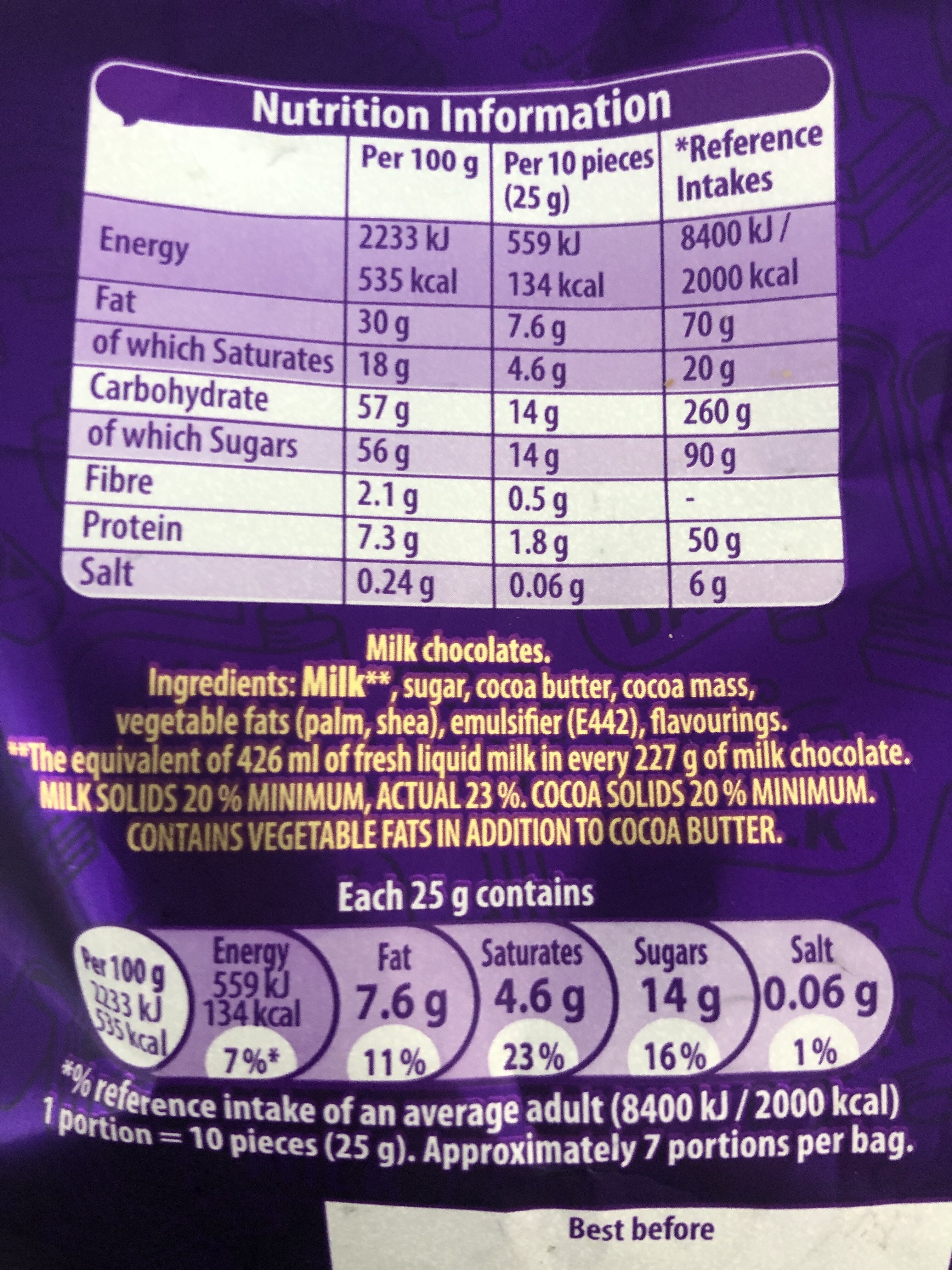🔬 Analysis Report
Original Image

AI-Generated Analysis
Nutritional Snapshot
Comparison of nutrients per serving against recommended daily guidelines for an average adult.
Calories
(7% of daily guideline)
Overall Product Summary
This milk chocolate product is high in sugar and fat, particularly saturated fat, making it a treat to be consumed in moderation. While it contains milk and cocoa, which offer some benefits, the presence of vegetable fats (palm, shea) and added sugar detracts from its overall nutritional value.
⚠️ Important Warnings
Allergen (Milk): Contains milk; not suitable for individuals with milk allergies or lactose intolerance.
High Sugar (Sugar): High in sugar; consume in moderation to avoid negative health effects.
High Saturated Fat (Vegetable Fats (palm, shea)): High in saturated fat; excessive consumption may negatively impact cardiovascular health.
Nutrition Facts Analysis
Ingredients Analysis
Milk
Status: ✔ Generally Good
Purpose: Provides texture, flavour, and nutritional content.
Description: Cow's milk, a common source of calcium and protein.
Benefits:
- ✨ Good source of calcium for bone health.
- ✨ Provides protein for muscle building and repair.
- ✨ Contains vitamins and minerals.
Drawbacks:
- ⚠️ Can be high in saturated fat depending on the type of milk.
- ⚠️ May cause digestive issues for lactose-intolerant individuals.
- ⚠️ Potential allergen.
Healthier Alternatives:
- 🌱 Plant-based milks (almond, soy, oat) for those with lactose intolerance or dairy allergies.
Sugar
Status: ✘ Caution Advised
Purpose: Sweetener.
Description: Refined sucrose, a common sweetener derived from sugar cane or sugar beets.
Drawbacks:
- ⚠️ Contributes to weight gain and obesity.
- ⚠️ Increases risk of type 2 diabetes.
- ⚠️ Promotes tooth decay.
- ⚠️ Can lead to energy crashes and cravings.
Healthier Alternatives:
- 🌱 Stevia
- 🌱 Erythritol
- 🌱 Monk fruit
- 🌱 Small amounts of honey or maple syrup.
Cocoa Butter
Status: ✘ Caution Advised
Purpose: Adds richness and texture.
Description: The fat extracted from cocoa beans.
Benefits:
- ✨ Contains antioxidants.
- ✨ May improve skin health.
Drawbacks:
- ⚠️ High in saturated fat, which can raise cholesterol levels.
- ⚠️ Contributes to calorie density.
Healthier Alternatives:
- 🌱 Using smaller amounts of cocoa butter.
- 🌱 Unsweetened cocoa powder (in other recipes).
Cocoa Mass
Status: ✔ Generally Good
Purpose: Provides chocolate flavour and antioxidants.
Description: Ground cocoa beans before the fat is extracted, providing the main chocolate flavour.
Benefits:
- ✨ Rich in antioxidants (flavonoids).
- ✨ May improve blood flow.
- ✨ Potential mood-boosting effects.
Drawbacks:
- ⚠️ Can be bitter on its own.
- ⚠️ May contain caffeine and theobromine (stimulants).
Vegetable Fats (palm, shea)
Status: ✘ Caution Advised
Purpose: Adds texture and stability.
Description: A blend of vegetable fats, often used for texture and cost reduction.
Drawbacks:
- ⚠️ Palm oil production contributes to deforestation and habitat loss.
- ⚠️ High in saturated fat.
- ⚠️ Shea butter can be high in saturated fat, depending on processing.
Healthier Alternatives:
- 🌱 Cocoa butter
- 🌱 Sunflower oil
- 🌱 Olive oil
Emulsifier (E442)
Status: ✘ Caution Advised
Purpose: Emulsifier.
Description: Ammonium phosphatides, used to bind ingredients together.
Drawbacks:
- ⚠️ Some studies suggest potential negative effects on the gut microbiome.
- ⚠️ Often derived from genetically modified soy.
Healthier Alternatives:
- 🌱 Lecithin (sunflower or soy)
- 🌱 No emulsifier (may affect texture)
Flavourings
Status: ✘ Caution Advised
Purpose: Adds flavour.
Description: A mixture of chemicals used to create or enhance flavour.
Drawbacks:
- ⚠️ Lack of transparency regarding the specific chemicals used.
- ⚠️ May contain allergens or sensitivities.
- ⚠️ Can mask the taste of lower-quality ingredients.
Healthier Alternatives:
- 🌱 Natural extracts (vanilla, peppermint)
- 🌱 Spices (cinnamon, nutmeg)